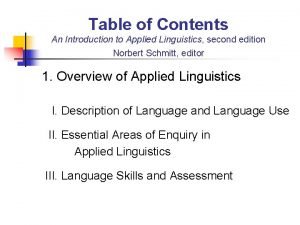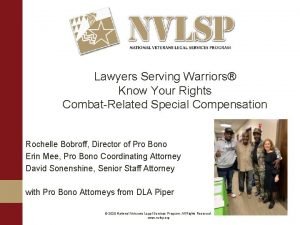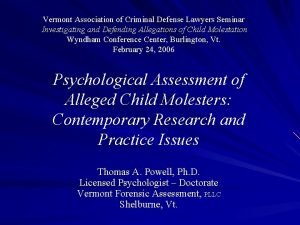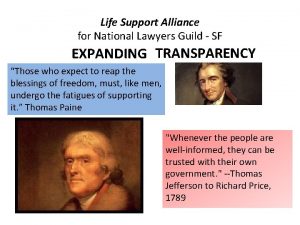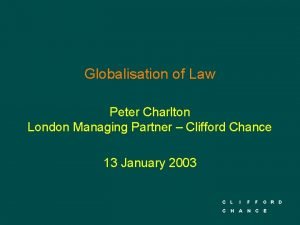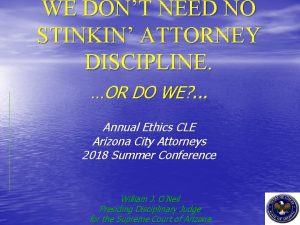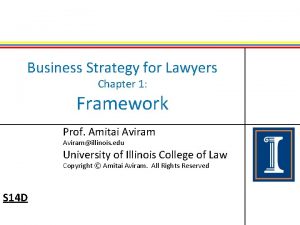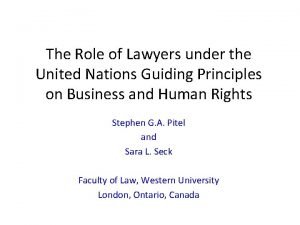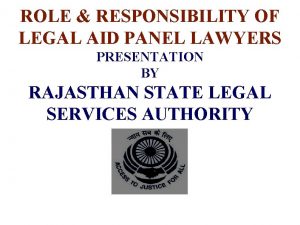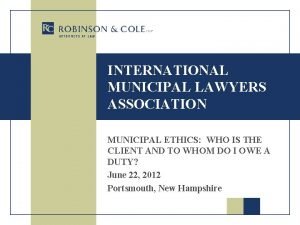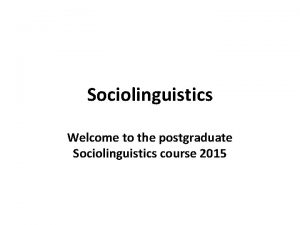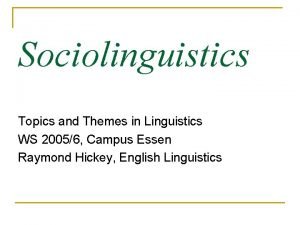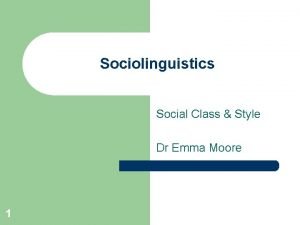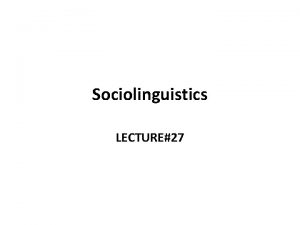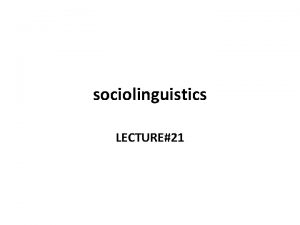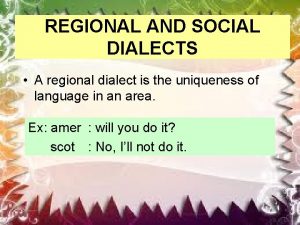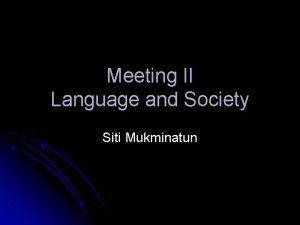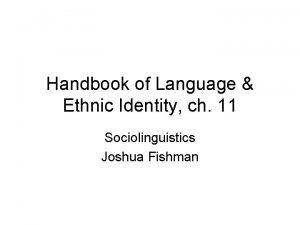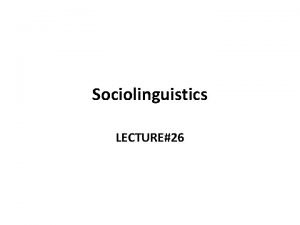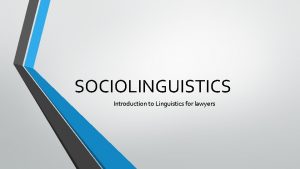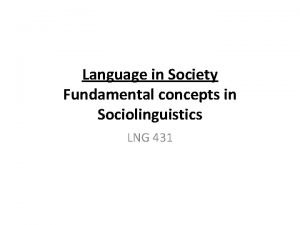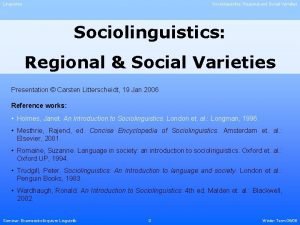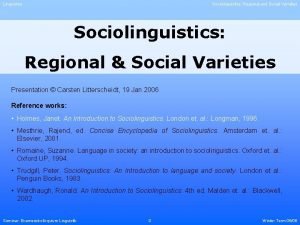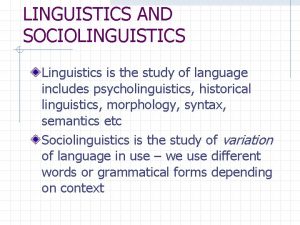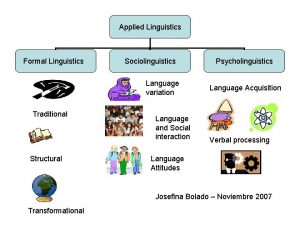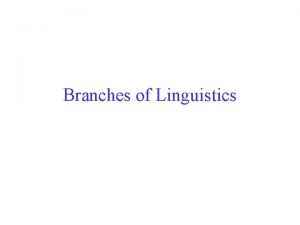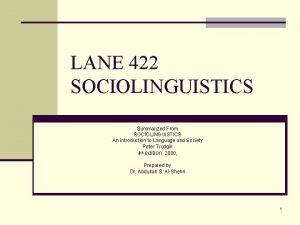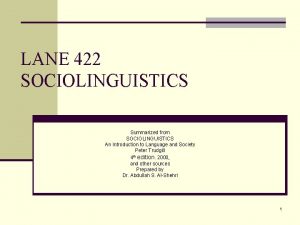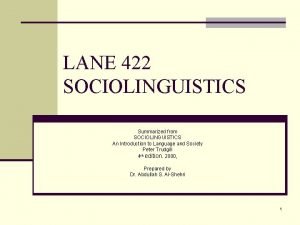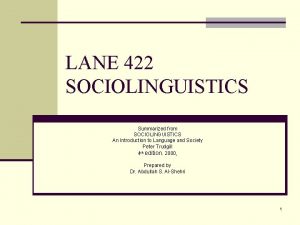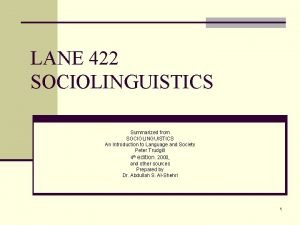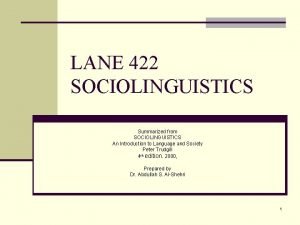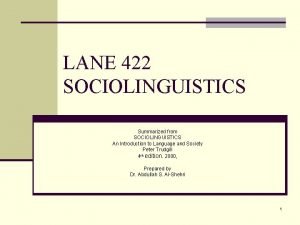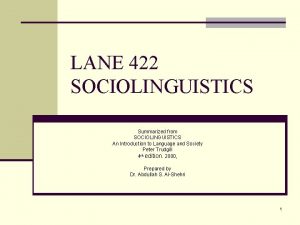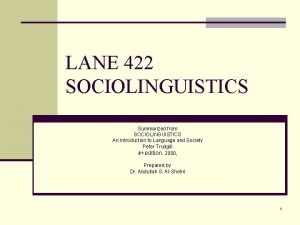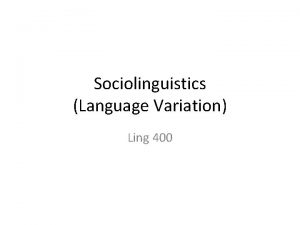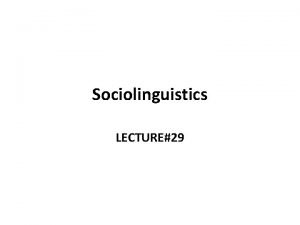SOCIOLINGUISTICS Introduction to Linguistics for lawyers What is




































- Slides: 36

SOCIOLINGUISTICS Introduction to Linguistics for lawyers

What is sociolinguistics? • Sociolinguistics is the study of lanuage use in its social contexts • While linguistics primarily analyses the structure of language, sociolinguistics analyses language function and use • Sociolinguistics – developed since 1960’s • No hard boundary between sociolinguistics and linguistics

Some basic sociolinguistic principles • Sociolinguistics – concerned with the complex relationship between language and society • 1) assumption that language reflects society (1960’s-1990’s), e. g. calling the judge „Your Honour” reflects the hierarchical authority structure in courtrooms • 2) assumption that language, or culture, determines aspects of society: Sapir-Whorf hypothesis

Some basic sociolinguistic principles • 21 st c. sociolinguistics assumes a dynamic and reciprocal relationship between language and society, so that language usage at the same time both reflects and shapes society

Some basic sociolinguistic principles • Language – characterised by variation • Variation can be studied along two dimensions: diachronic and synchronic • Diachronic variation – all languages change over time • Synchronic variation – differences in the ways in which language is used in the same time period; people speak differently in different contexts

Some basic sociolinguistic principles • • Language variation – ubiquitous and related to social factors • • Cover term ‘variety’ refers to both languages and dialects Dialects – forms of a language which are generally mutually intelligible, and which differ from each other in systematic ways, such as in accent, grammar, words and thier meaning, and communication patterns Differences between social groups based on ethnicity or geographical and/or political space often correspond to the use of different language varieties

Variation • Can be attributed to social factors such as geographical location, socio- economic background, level of education, age and gender, as well as situational and contextual factors: who is speaking to whom about what and where

Variation • Languages show variety at all levels: in their genres, text types, lexicogrammar and phonology • This variation is witnessed when we move across social registers and geographical locations, encountering different speech communities along our way

Speech community • • • Defined by the language they use, as their language use forms their boundaries Speech community is a product of the communicative activities engaged in by a group of people A speech community – not identifiable only on the basis of spoken language Throughout our lives we may belong to different speech communities synchronically and diachronically as we move in and out of different communities Communities that we choose to belong to based on written language – discourse communities (e. g. acadmic journals, Internet groups) Individual way of using laguage - idiolect

Exercise • Make a list of speech/discourse communities that you consider yourself a part of • Make a list of any expressions you use with your family that you perhaps avoid outside that sphere. Include expressions used to refer to other family members, to food, family practices etc. • Think back of your own language use over your life. How has it changed?

Diglossia • • • Charles Fergusson used the term to refer to specific situations in which two varieties of the same language exist: the high variety (H) and the low variety (L) Varieties – used for separate functions: H for official purposes, L for informal communication L – language of the home, H – learned at school H- long-standing literary tradition, L – no literary tradition Examples: High German and Swiss German, Katharevousa versus spoken Demotic Greek, classical Arabic vs. Spoken Arabic, standard French vs. Haitian Creole

Pidgins and Creoles • A pidgin – a hybrid of two languages which comes into existence in an area where at least two different langage groups come into contact; extremely simplified structure; a language with no native speakers • Creole – if a pidgin is passed on to new generations, its structure and vocabulary gradually develop - creole

Sociolect • Ways how a certain group of people uses language (socio-economic background, gender, age, occupation influence how we use language)

Language variation based on gender • Robin Lakoff (1975) Language and Woman’s Place: ways in which women’s language differs from that of men: women use more hedging (sort of, guess so) and tag questions (…isn’t it? ), they apologize more and use more ‘empty’ adjectives (‘cute, wonderful, fantastic’) • Women’s language choices put them forth as lacking in power and authority and as seeking approval • Little girls – socialized into language use scolded for not talking as nice little girls should

Gender • W. O’Barr and B. Atkins (1980) in their study of language in a courtroom, challenge Lakoff’s assumption that the features she suggests are typical of female speech; they argue that these features are present in females and males who are in a position of powerlessness

Gender • • • Janet Holmes (1990) characterized Lakoff’s list as functional; i. e. Lakoff identified linguistic features which function to express epistemic modality – the degree of certainty that we have about a proposition, as well as the speaker’s affective stance toward the person(s) with whom they are interacting Intonation should also be taken into account as the illocutionary force can vary greatly depending on how it is uttered Differences between male and female speech – not in the frequency of use, but rather in ways the features were used by women which included positive politeness strategies suggesting that women used language to be facilitative and collaborative

Exercise • Robin Lakoff’s research is from forty years ago. Do you think that women’s ways of speaking have changed? Have the ways in which girls and boys are socialized into language changed?

Age • The language we use changes over our lifetime • Adolescence – a particularly ripe time for language development, as adolescents want to mark themselves as different from their parents’ generation • A high degree of phonological innovation during adolescence (Eckert 1988)

Variation based on occupation • • Jargon – language specific to an occupation Field-specific terms – not easily understood by outsiders English for specific purposes (ESP) – acknowledgment of the need to learn the language of a field and not just the language in general; debate on whether or not language teachers can teach people the concepts from a field that they are not active members of, as knowing how to use a work or phrase means understanding the concept it refers to Words which may look familiar sometimes take a different meaning within a specialized field

Register • Dialects and sociolects – varieties of language based on personal characteristics, e. g. a region where a person comes from, social class, gender, age, occupation • • • Dialect and sociolect refer to language variation based on the users of the language Register – refers to variation based on the social context in which language is used Registers – formal and informal

Speech accomodation • Leads us to position ourselves with respect to other speakers through convergence or divergence • Speakers converge when they want to reduce the social distance • They diverge when they want to emphasize their distinctiveness or increase their social distance

Lexical variation • As we move across social and geographical communities within a wider speech community, we find differences in words and expressions used to refer to the same or similar items or phenomena

Sound variation • The sounds can vary across speakers in terms of word stress, intonation and articulation

Morphosyntactic variation • Features from dialects viewed as incorrect (He don’t know nothin’; Everybody knowed him)

Different kinds of sociolinguistic analysis • All sociolinguistic analysis – empirical basis; collecting evidence of actual language use

Different kinds of sociolinguistic analysis • Ethnography of speaking/ethnography of communication • Variationist sociolinguistics • Sociology of language • Critical sociolinguistics • Descriptive linguistics • Discourse analysis

Ethnography of communication • Studies the ways of speaking (or communicating) in a speech community • Uses anthropological approach in which researchers are interested in how members of a social group live, and in learning about their beliefs, values and practices from careful observation (rather than e. g. interviews)

Variationist sociolinguistics • Studies patterns and structures of language variation, often using quantitative analysis • Initially this approach correlated social variables such as age, gender and socioeconomic class with language variation • Increasingly this is being broadened to examine dynamic interactions between variations in ways of using language and ways in which speakers can actively fine-tune a wide range of aspects of their social identity

Sociology of language • Focuses on society-level issues involving language • Topics include language choice and language policy and planning in multilingual contexts • Macroanalysis

Critical sociolinguistics • Uses a range of sociolinguistic approaches (both macro and micro) in combination with social theoretical analysis to examine the role of language in power relationships

Descriptive linguistics • Studies the structure of language and it complements ad accompanies much sociolinguistic analysis • Uses a number of analytical approaches: phonetics/phonology, morphology, syntax, semantics

Discourse analysis • Studies language use beyond the sentence level, whether in face-to-face interactions such as conversations, interviews, public speeches, or written communication such as newspaper articles or codified laws • Sociolinguistic discourse analysis pays attention not just to the content of what is said but how it is said, examining linguistic dimensions, such as grammar, accent, word choice, turn-taking and context

Discourse analysis • Conversation analysis • Interactional sociolinguistics • Critical Discourse Analysis

Conversation Analysis (CA) • Focuses on everyday conversations, but is increasingly being used in the study of institutional talk, such as in courtrooms • Sociological tradition of ethnomethodology; focus on the structure of conversations and on how this is cooperatively managed by participants

Interactional sociolinguistics • In contrast to CA, highlights contextual and cultural dimensions of language and interaction

Critical Discourse Analysis (CDA) • Examines the ways in which language use (or discourse practices) reproduce and/or trasform power relations within society
 Traditional linguistics and modern linguistics
Traditional linguistics and modern linguistics Difference between linguistics and applied linguistics
Difference between linguistics and applied linguistics George yule
George yule A concise introduction to linguistics answer key
A concise introduction to linguistics answer key An introduction to applied linguistics
An introduction to applied linguistics Cognitive linguistics: an introduction
Cognitive linguistics: an introduction Going concern
Going concern Rochelle bobroff
Rochelle bobroff Vermont association of criminal defense lawyers
Vermont association of criminal defense lawyers Mental health lawyers association
Mental health lawyers association Life support alliance
Life support alliance Immigration lawyers charlton
Immigration lawyers charlton Premium digital marketing for lawyers
Premium digital marketing for lawyers Lawyers oath
Lawyers oath Seapil
Seapil Pro bono lawyers in alabama
Pro bono lawyers in alabama Business strategy for lawyers
Business strategy for lawyers United nations basic principles on the role of lawyers
United nations basic principles on the role of lawyers Deepwater horizon oil spill
Deepwater horizon oil spill Legal aid panel
Legal aid panel International municipal lawyers association
International municipal lawyers association Sports lawyers in india
Sports lawyers in india International association of korean lawyers
International association of korean lawyers Progress lawyers
Progress lawyers Variationist sociolinguistics
Variationist sociolinguistics Sociolinguistics topics
Sociolinguistics topics Variationist sociolinguistics
Variationist sociolinguistics Language dialect and varieties in sociolinguistics
Language dialect and varieties in sociolinguistics Sociolinguistics
Sociolinguistics Sociolinguistics
Sociolinguistics Difference between regional dialect and social dialect
Difference between regional dialect and social dialect What is sociolinguistics
What is sociolinguistics Solidarity social distance scale
Solidarity social distance scale Ethnicity in sociolinguistics
Ethnicity in sociolinguistics Code switching in sociolinguistics
Code switching in sociolinguistics Register (sociolinguistics)
Register (sociolinguistics) Sociolinguistics examples
Sociolinguistics examples




